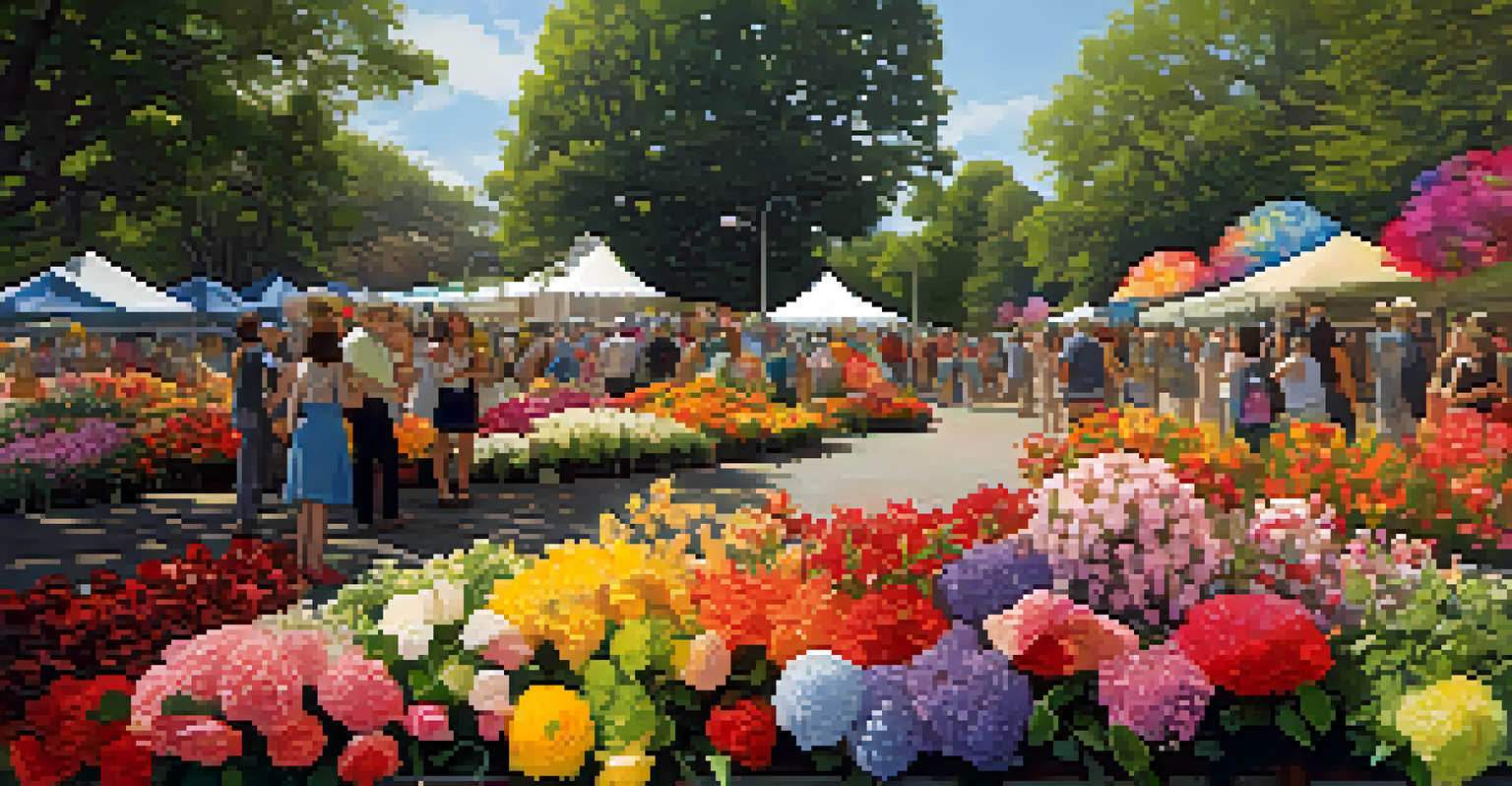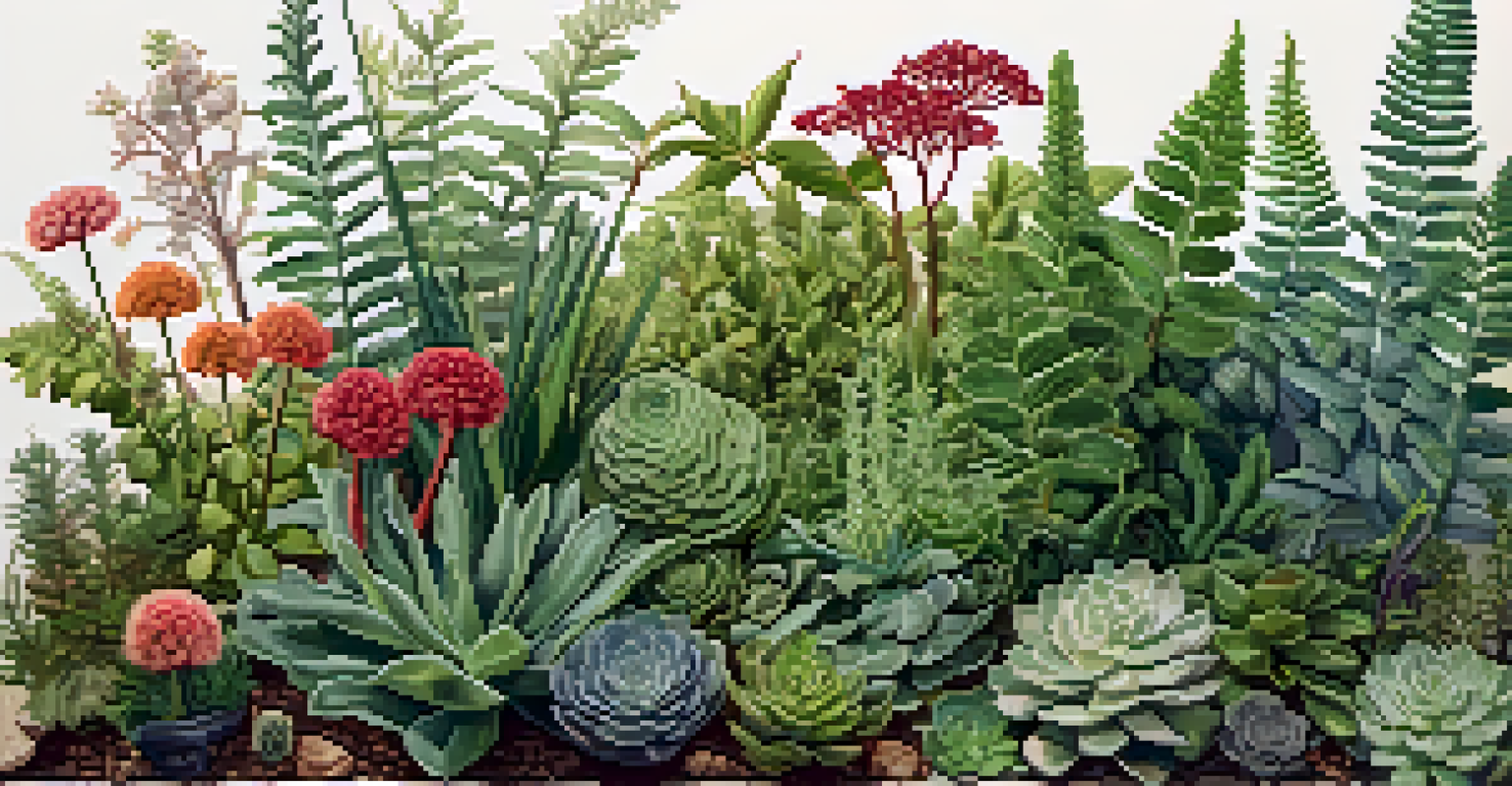Botanical Art and Its Celebration in Plant Festivals

What is Botanical Art? A Brief Overview
Botanical art is a unique blend of art and science that captures the beauty and intricacy of plants. This form of art goes beyond mere representation; it aims to showcase the details and characteristics of each plant. Artists often use various mediums such as watercolor, photography, and even sculpture to illustrate their subjects.
Botanical art is a bridge between science and art, helping us understand the beauty and complexity of the natural world.
The roots of botanical art can be traced back to the 15th century, where it served both aesthetic and scientific purposes. Artists would meticulously document plants for scientific studies, helping to catalog the world's flora. Today, botanical art continues to evolve, embracing modern techniques while honoring its historical significance.
What sets botanical art apart is its commitment to accuracy and detail. Artists often study their subjects in-depth, ensuring that every leaf, petal, and stem is depicted with precision. This dedication not only creates stunning visuals but also contributes to the appreciation of plant life and biodiversity.
The Historical Significance of Botanical Art
Throughout history, botanical art has played a crucial role in the documentation of plant species. In the age of exploration, artists accompanied scientists on voyages, illustrating newly discovered plants for the first time. These artworks provided valuable information for medicinal and agricultural use, marking the beginning of a rich tradition.

One famous example is the work of Maria Sibylla Merian, a 17th-century artist who traveled to Suriname. Her detailed studies of insects and plants not only advanced scientific knowledge but also highlighted the interconnectedness of life. Such contributions paved the way for future botanical artists, blending artistic creativity with scientific inquiry.
Botanical Art Blends Science and Art
This unique art form captures the beauty of plants while emphasizing accuracy and detail, showcasing the intricacies of flora.
As we reflect on the historical context of botanical art, it's clear that these works have transcended their time and purpose. They serve as a bridge between art and science, reminding us of the importance of preserving our natural world while celebrating its beauty.
The Role of Plant Festivals in Celebrating Botanical Art
Plant festivals around the world serve as vibrant platforms to celebrate botanical art. These events bring together artists, botanists, and enthusiasts, creating an immersive environment where plant life takes center stage. From flower shows to garden exhibitions, festivals showcase stunning artworks that inspire and educate attendees.
Art is the most beautiful of all lies; it makes us see the world as it should be, not just as it is.
At these festivals, you can often find live demonstrations, workshops, and exhibitions dedicated to botanical art. Artists share their techniques, revealing the meticulous processes behind their creations. This interaction not only fosters appreciation for the art form but also encourages budding artists to explore their own creativity.
Moreover, plant festivals often emphasize the significance of conservation. Many artworks highlight endangered species or promote native plants, reminding us of our responsibility to protect biodiversity. In this way, botanical art becomes a powerful tool for advocacy, raising awareness about environmental issues while captivating the public's imagination.
Famous Botanical Art Exhibitions and Festivals
Several renowned botanical art exhibitions and festivals attract thousands of visitors each year. One of the most famous is the Chelsea Flower Show in London, which features stunning displays from top botanical artists. This prestigious event not only showcases exceptional floral designs but also highlights the intricate beauty of botanical art.
Another notable event is the Philadelphia Flower Show, the largest indoor flower show in the world. It includes a dedicated section for botanical art, where artists exhibit their works alongside breathtaking floral arrangements. Visitors are often left in awe, as they witness the harmonious blend of nature and artistry.
Plant Festivals Celebrate Botanical Art
These vibrant events unite artists and enthusiasts, promoting conservation and appreciation for plant life through exhibitions and workshops.
These festivals are not just about visual appeal; they also provide educational opportunities. Many exhibitions include talks and workshops led by experts, offering insights into the techniques and history of botanical art. Attendees leave with a deeper understanding and newfound appreciation for this captivating art form.
Modern Trends in Botanical Art
In recent years, botanical art has seen a resurgence in popularity, driven by a growing interest in sustainability and nature. Contemporary artists are experimenting with new materials and techniques, infusing traditional practices with modern flair. This evolution keeps the art form fresh and relevant, attracting a diverse audience.
Social media platforms play a significant role in this trend, allowing artists to share their work with a global audience. Hashtags like #BotanicalArt and #PlantArt have created vibrant online communities where artists and enthusiasts can connect. This exposure has led to new opportunities for collaboration and innovation in the field.
Furthermore, many modern botanical artists are focusing on themes of conservation and environmental awareness. Their work often highlights the beauty of native plants and ecosystems, urging viewers to consider their impact on the environment. This blend of art and activism not only inspires creativity but also fosters a sense of responsibility towards nature.
How to Get Involved in Botanical Art
If you're interested in exploring botanical art, there are many ways to get involved, regardless of your skill level. Local art classes and workshops often offer courses specifically focused on botanical illustration. These classes provide a supportive environment where you can learn techniques and develop your own style.
Additionally, many botanical gardens and arboretums host events and exhibitions centered around botanical art. Attending these events can be a great way to meet like-minded individuals, learn from experts, and immerse yourself in the beauty of plant life. You might even discover local artists whose work resonates with you.
Modern Trends Embrace Sustainability
Contemporary botanical artists are focusing on environmental themes and utilizing social media to connect with a global audience.
For those who prefer a more independent approach, consider starting your own botanical sketchbook. Spend time outdoors, observing and capturing the plants that inspire you. This practice not only enhances your artistic skills but also deepens your connection to nature, allowing you to appreciate the intricate details of the world around you.
The Future of Botanical Art and Plant Festivals
As we look to the future, the relationship between botanical art and plant festivals is likely to grow even stronger. With increasing awareness of environmental issues, artists and festival organizers are finding new ways to engage the public. This synergy will continue to highlight the importance of conservation while celebrating the beauty of nature.
Emerging technologies, such as digital art and virtual reality, may also play a role in the evolution of botanical art. These innovations could enhance the way we experience and appreciate plant life, making botanical art more accessible to a wider audience. Imagine exploring a virtual garden filled with stunning digital illustrations of rare plants!

Ultimately, the future of botanical art depends on the passion and creativity of artists, educators, and enthusiasts alike. By fostering a love for nature and encouraging artistic expression, we can ensure that botanical art continues to thrive, inspiring generations to come. As we celebrate this art form at plant festivals, we not only honor the beauty of plants but also our connection to the natural world.